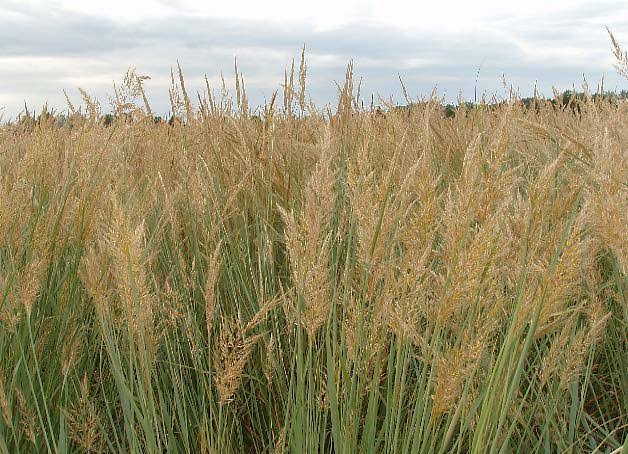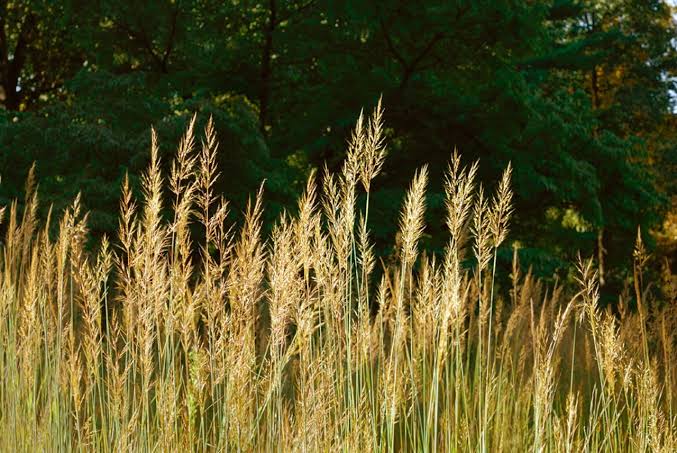Yellow Indiangrass (Sorghastrum nutans) is a splendid native grass found in North America, adding charm to landscapes with its golden hues. This resilient plant thrives in a variety of habitats, from prairies to open woodlands, showcasing its adaptability.
In appearance, Yellow Indiangrass stands tall with graceful stems, reaching heights of up to 7 feet. Its slender leaves sway with the wind, creating a mesmerizing dance in the fields. During late summer and fall, the grass blooms into a spectacle of golden inflorescences, casting a warm glow across the surroundings.
This grass plays a crucial ecological role by providing habitat and sustenance for various wildlife. Birds find refuge in its dense foliage, while the seeds serve as a delectable treat for many species. Additionally, Yellow Indiangrass contributes to soil health, preventing erosion and promoting stability in diverse ecosystems.
Gardeners and conservationists appreciate the low-maintenance nature of Yellow Indiangrass. Its adaptability to different soil types and resistance to pests make it a resilient choice for landscaping projects. Beyond its aesthetic appeal, this grass aids in restoring disturbed landscapes, acting as a natural pioneer species.
As an ornamental grass, Yellow Indiangrass captivates with its radiant color and dynamic presence. Landscapes adorned with this native beauty evoke a sense of harmony and connection with the natural environment. Whether planted in gardens, meadows, or along roadsides, the graceful silhouette of Yellow Indiangrass enhances the visual appeal of diverse settings.
In addition, Yellow Indiangrass (Sorghastrum nutans) is a remarkable native grass that embodies the beauty and resilience of North American landscapes. Its golden allure, ecological significance, and adaptability make it a valuable asset in both natural and cultivated environments, enriching the tapestry of the great outdoors.
Read Also: Balinese Cat Breed Description and Complete Care Guide
How To Grow Yellow Indiangrass (Sorghastrum nutans)

To grow Yellow Indiangrass (Sorghastrum nutans), follow these steps:
1. Select an Appropriate Site: Choose a sunny location with well-draining soil.
2. Soil Preparation: Ensure the soil is loose and fertile. Incorporate organic matter if needed.
3. Planting: Sow Yellow Indiangrass seeds directly into the soil in late fall or early spring. Press seeds lightly into the soil without covering too deeply.
4. Watering: Keep the soil consistently moist during germination. Once established, the grass is relatively drought-tolerant.
5. Maintenance: Minimal care is needed once established. Occasional watering during dry spells may be beneficial.
6. Pruning: While not necessary, trimming in late winter or early spring can promote healthier growth.
7. Fertilization: Yellow Indiangrass generally doesn’t require heavy fertilization. If needed, use a balanced fertilizer in spring.
8. Weed Control: Remove weeds around young plants to reduce competition. Mature Yellow Indiangrass helps suppress weed growth.
9. Wildlife Considerations: Be mindful of wildlife, especially birds attracted to the seeds. If preserving seeds for wildlife, avoid extensive pruning until seeds have dispersed.
10. Enjoy the Beauty: Sit back and appreciate the beauty of Yellow Indiangrass as it grows, contributing to the aesthetics of your landscape.
11. Maturity: Yellow Indiangrass reaches full maturity in its second or third year. During this time, it will develop its characteristic height and graceful appearance.
12. Drought Resistance: As the grass matures, it becomes more resistant to drought conditions. This makes it an excellent choice for landscapes where water conservation is a consideration.
13. Seed Dispersal: In late summer and fall, Yellow Indiangrass produces distinct golden inflorescences. Be aware that seeds will be dispersed, contributing to the grass’s natural propagation.
14. Erosion Control: The extensive root system of Yellow Indiangrass plays a role in preventing soil erosion, making it a valuable addition to areas prone to erosion.
15. Naturalization: Consider allowing Yellow Indiangrass to naturalize in your landscape, creating a harmonious and self-sustaining ecosystem.
16. Biodiversity: This native grass attracts various pollinators, adding to the biodiversity of your garden. Bees and butterflies are particularly drawn to the golden blooms.
17. Fall Color: Embrace the vibrant fall color of Yellow Indiangrass, as its foliage turns a warm golden hue, adding visual interest to autumn landscapes.
18. Resilience: Yellow Indiangrass is adapted to various climates and soil types, showcasing resilience in different environmental conditions.
19. Landscaping Versatility: Whether in a meadow, garden, or naturalized area, Yellow Indiangrass enhances the overall beauty and aesthetics of diverse landscapes.
How To Care For Yellow Indiangrass (Sorghastrum nutans)
Caring for Yellow Indiangrass (Sorghastrum nutans) involves simple steps to maintain its health and aesthetic appeal:
1. Watering: Initially, keep the soil consistently moist during the germination phase. Once established, Yellow Indiangrass is drought-tolerant, requiring occasional watering during prolonged dry spells.
2. Pruning: While Yellow Indiangrass doesn’t necessitate frequent pruning, a light trim in late winter or early spring can encourage healthier growth and maintain an attractive form.
3. Fertilization: Yellow Indiangrass typically doesn’t demand heavy fertilization. If the soil lacks nutrients, apply a balanced fertilizer in the spring.
4. Weed Control: Remove weeds around young plants to minimize competition for resources. Once mature, the dense growth of Yellow Indiangrass helps suppress weed development.
5. Wildlife Considerations: Be mindful of wildlife, particularly birds attracted to the seeds. If preserving seeds for wildlife is a goal, avoid extensive pruning until seeds have dispersed.
6. Maturity: Yellow Indiangrass reaches full maturity in its second or third year. At this point, it becomes more resistant to drought conditions and develops its characteristic height and appearance.
7. Erosion Control: Take advantage of Yellow Indiangrass’s extensive root system, which aids in preventing soil erosion. This makes it particularly valuable for areas prone to erosion.
8. Naturalization: Allow Yellow Indiangrass to naturalize in your landscape for a self-sustaining ecosystem. This can enhance biodiversity and promote a more ecological balance.
9. Biodiversity: Embrace the diverse pollinators attracted to Yellow Indiangrass. Bees and butterflies are particularly drawn to its golden blooms, contributing to the biodiversity of your garden.
10. Fall Color: Appreciate the vibrant fall color of Yellow Indiangrass as its foliage turns a warm golden hue, adding visual interest to autumn landscapes.
11. Resilience: Recognize the resilience of Yellow Indiangrass in various climates and soil types, adapting well to different environmental conditions.
12. Landscaping Versatility: Whether in a meadow, garden, or naturalized area, Yellow Indiangrass enhances the overall beauty and aesthetics of diverse landscapes.
13. Seasonal Interest: Enjoy the ornamental qualities of Yellow Indiangrass throughout the year, appreciating its unique charm in every season.
Read Also: Birman Cat Breed Description and Complete Care Guide
The Uses of Yellow Indiangrass (Sorghastrum nutans)

Yellow Indiangrass (Sorghastrum nutans) serves various practical and ecological purposes:
1. Landscaping: Widely used in landscaping, Yellow Indiangrass adds aesthetic appeal with its tall, graceful form and golden inflorescences. It is employed in gardens, meadows, and naturalized areas for its visual impact.
2. Soil Conservation: The extensive root system of Yellow Indiangrass aids in preventing soil erosion, making it a valuable asset in areas prone to erosion. It helps stabilize soil and contributes to overall conservation efforts.
3. Wildlife Habitat: The grass provides habitat for wildlife, especially birds. The seeds are a food source for various bird species, supporting biodiversity in the ecosystem.
4. Pollinator Attraction: The golden blooms of Yellow Indiangrass attract pollinators like bees and butterflies. This not only enhances the beauty of the landscape but also contributes to the health of pollinator populations.
5. Drought-Tolerant Landscapes: Yellow Indiangrass is well-suited for landscapes that require drought-resistant plants. Once established, it can thrive with minimal water, making it a sustainable choice for water-conscious gardening.
6. Restoration Projects: Often used in ecological restoration projects, Yellow Indiangrass plays a role in reestablishing native plant communities. Its adaptability and resilience make it valuable in restoring disturbed landscapes.
7. Forage for Livestock: While not as widely used as some other grasses, Yellow Indiangrass can provide forage for livestock in certain regions. It offers a source of nutrition for grazing animals.
8. Erosion Control: Beyond preventing soil erosion, the dense growth of Yellow Indiangrass contributes to overall erosion control measures. It is particularly effective on slopes and areas with vulnerable soil.
9. Educational Purposes: Yellow Indiangrass is sometimes used in educational settings to showcase native flora. Its growth cycle, adaptation to different environments, and ecological interactions make it an interesting subject for study.
10. Cultural and Historical Significance: In some regions, Yellow Indiangrass holds cultural and historical importance. It may have been used by indigenous communities for various purposes, including traditional medicine or craft materials.
Understanding and appreciating the diverse uses of Yellow Indiangrass highlights its ecological importance and its ability to contribute to both natural and cultivated landscapes.
Frequently Asked Questions (FAQs)
Q1: How tall does Yellow Indiangrass grow?
A1: Yellow Indiangrass (Sorghastrum nutans) can reach heights of up to 7 feet, creating a tall and graceful presence in the landscape.
Q2: When is the best time to plant Yellow Indiangrass seeds?
A2: Ideally, sow Yellow Indiangrass seeds in late fall or early spring. This allows for natural stratification and enhances germination.
Q3: Does Yellow Indiangrass require a lot of water?
A3: While it needs consistent moisture during germination, Yellow Indiangrass becomes relatively drought-tolerant once established. Occasional watering during dry spells is generally sufficient.
Q4: How often should I prune Yellow Indiangrass?
A4: Pruning is not frequently required. However, a light trim in late winter or early spring can promote healthier growth and maintain an attractive form.
Q5: Can Yellow Indiangrass grow in different soil types?
A5: Yes, Yellow Indiangrass is adaptable to various soil types. It thrives in well-draining soil but can tolerate different conditions.
Q6: Does Yellow Indiangrass attract wildlife?
A6: Yes, Yellow Indiangrass attracts wildlife, especially birds. The seeds serve as a food source, contributing to biodiversity in the ecosystem.
Q7: Is Yellow Indiangrass suitable for erosion control?
A7: Absolutely. The extensive root system of Yellow Indiangrass makes it effective for preventing soil erosion, particularly in areas prone to erosion.
Q8: Can I use Yellow Indiangrass in landscaping projects?
A8: Yes, Yellow Indiangrass is commonly used in landscaping for its aesthetic appeal. It adds visual interest to gardens, meadows, and naturalized areas.
Q9: Does Yellow Indiangrass have any cultural significance?
A9: In some regions, Yellow Indiangrass may have cultural and historical importance. It could have been used by indigenous communities for various purposes.
Q10: How long does it take for Yellow Indiangrass to reach maturity?
A10: Yellow Indiangrass typically reaches full maturity in its second or third year, displaying its characteristic height and appearance.
